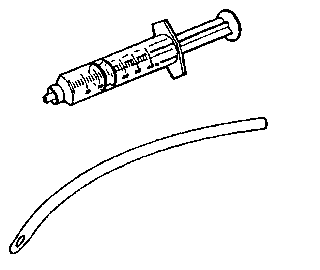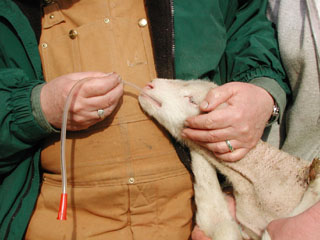Weak Lamb or Kid Feeding Unit

| 60
mL plastic syringe
16-18 inch feeding catheter (#18 French) |
|
Weak Lamb or Kid Feeding Unit |
||||
 |
|
|||
 |
|
 |
|
 |
|
|
If the video
does not play, you must install an MPEG video |
Stomach Tube Placement in an Adult
|
|
| This diagram shows the use
of an oral tube in an adult animal. Performing this procedure would be
warranted when the animal is bloated and requires gas to be released from
the rumen. This method may also be used to pump large amounts of fluid
into the animal. If only small amounts of fluid are required, a drenching
gun can also be used (see page C174).
After inserting the tube past the throat region, feel on the left side of the windpipe (trachea) for the tube. If the tube is in the proper location (the esophagus), the tube can be felt by sliding it in and out. If it cannot be felt, the tube should be removed and reinserted again. Once it is certain the tube is in the esophagus, the tube can be gently passed into the rumen. If the tube is in the rumen, the air coming out can be smelled, identifying the typical rumen odor. While someone is listening to the rumen with a stethoscope, blow on the end of the tube. A gurgling noise should be heard in the rumen. This will ensure the tube is in the right place. Never administer any fluids until the tube can be positively identified. Death can result if fluids are administered into the lungs! |